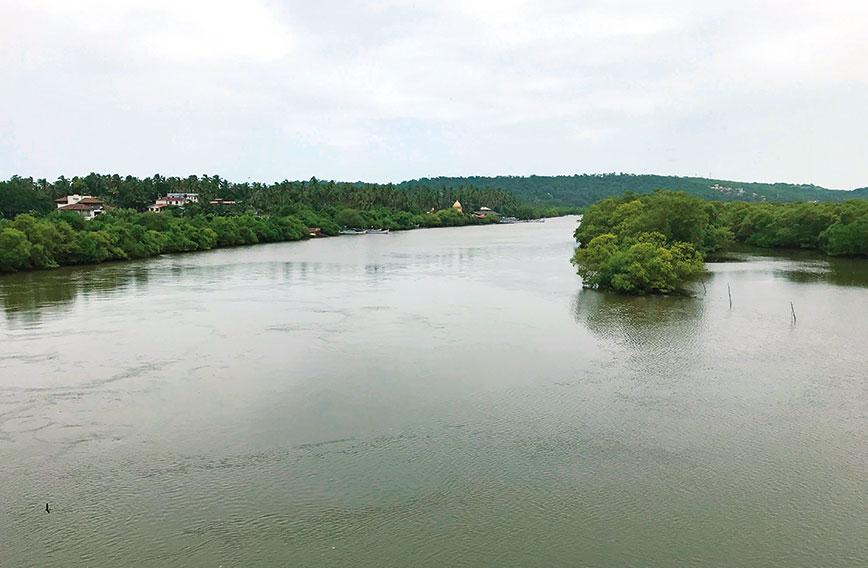
VENKATESH DUTTA
IN my city I often search for a spot by the side of the Gomti river which looks somewhat wild and scenic. My quest has been futile. Fifteen years ago, I discovered a small stretch, almost 30 km from my home, where I could sit peacefully, reflect and spot fish. It had well-vegetated banks with natural plants. I could hear the naad of flowing water and the chirping of birds, take a boat and navigate for some time. But alas, that too has gone due to the emergence of a filthy drain outfalling into the river.
There has been a catastrophic reduction of wilderness in our urban and suburban areas. Expanding real estate has really killed landscape aesthetics and ruined scenic spots. In many other cities nowadays, finding a river that is untouched and scenic is really difficult. In the past 50 years, we have slowly but surely poisoned our life-streams. We have not learnt to value and guard nature’s priceless gifts.
Rivers are more than just converging linear channels of water; they are linked to entire catchments by the whole hydrological cycle’s inherently occurring phenomena. A river forms a ‘mosaic of habitat’ connecting its floodplains with ponds, wetlands, shrubs and forests. The two sides of the rivers — referred to as ‘fluvial terraces’ — are high-energy ecosystems. They support unique biodiversity — a large variety of plants and animals thrive in their flowing water. Lakes, streams, forests, perennial vegetation and aquatic plants are all hydrologically connected with one another — they define a local catchment. How many of us respect a river’s right to have its fluvial terrace and its connections with vegetated banks and corridors?
The US Congress passed the Wild and Scenic Rivers Act in 1968 and declared that “rivers that possess outstandingly remarkable scenic, recreational, geologic, fish and wildlife, historic, cultural or other similar values, shall be preserved in free-flowing condition, and that they and their immediate environments shall be protected for the benefit and enjoyment of present and future generations”.
The entire river does not have to be included in the designated stretches; rather, it might also contain its tributaries. As of March 2020, this Act will have protected a total of 226 rivers throughout 41 states, and their combined length will amount to nearly 22,000 km. Though, this length is not even one percent of the total length of rivers in the US.
According to this Act, rivers can be wild, scenic, or recreational, depending on their naturalness — wild rivers are those rivers or parts of rivers that do not have any impoundments or dams, their water is unpolluted, and their banks and shorelines are primitive and undeveloped. They are generally inaccessible except by walking trails. Scenic rivers have all the above properties except that they are accessible in some areas by roads. On the other hand, rivers are considered recreational if they are easily accessible by road or railroad and may have some development along their banks and shorelines. They may have been subjected to impoundment or diversion in the past.
All rivers are managed with the same overarching objective: preserving and developing the qualities that led to their designation. The goal of such acts and provisions is to permanently safeguard some of the country’s most exceptional free-flowing rivers while still allowing for dams and other buildings at appropriate sections of rivers. Funding for projects that would compromise the river’s free-flowing condition, or affect water quality or exceptional resource value is prohibited.
Canada’s Heritage Rivers System (CHRS), started in 1984, is similar to the US Act. Similarly, wild and pristine rivers in New Zealand are protected by law for their scenic and recreational value as well as their role in maintaining habitat. However, such wild and scenic rivers in India are becoming things of the past. The water quality is deteriorating and the natural flow regime is compromised. Decreasing habitat quality in our rivers is a major contributor to declining biodiversity and altered ecological processes.
Degradation of native habitats poses a significant threat to fish in particular. Large tracts of forests in the upper Ganga basin and other important river basins are being cleared to make way for agriculture, hydropower generation, and human settlements. Fish communities are becoming more homogeneous in space and time, and in function as a result of deforestation in the floodplains. The IUCN (International Union for Conservation of Nature) has updated its list of endangered animals to include many freshwater species.
We have only a handful of rivers that can still be described as ‘genuinely wild’ and ‘free-flowing’, if any at all. There are many rivers whose past glory has been largely lost to time. They have transformed from ‘pristine’ to ‘heavily modified’. The key to successfully preserving the wild character of a river is to focus on conserving the wilderness characteristics of its immediate catchments or fluvial terraces. Many rivers will likely be damaged, lose their wilderness, and stop providing essential ecological services if they are not protected.
One of the first steps in better conservation would be to consistently and regularly identify our surviving wild and scenic rivers and river stretches. Designating such stretches as scenic might help to sustain their high conservation benefits. Wild and scenic rivers support a rich habitat with amazing plants and animals including a large variety of fishes. These rivers may also contain native sites and natural artifacts that can be located and preserved.
Can we have a few stretches of the rivers even in our cities which are truly scenic — not by ugly ‘concrete riverfronts’ but by naturalness?
Venkatesh Dutta is a Gomti River Waterkeeper and a professor of environmental sciences at Ambedkar University, Lucknow.
Comments
Currently there are no Comments. Be first to write a comment!




